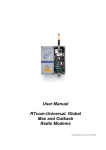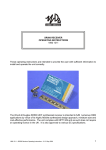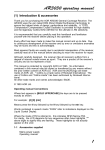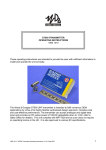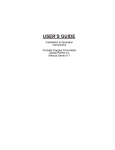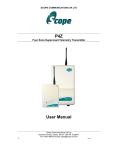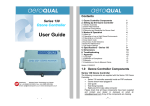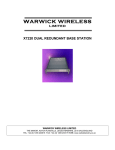Download RTcom Radio Modems User manual
Transcript
USER MANUAL RTcom–Universal, Global, Europa and Outback Radio Modems Distributor: Wessex Power Technology Ltd 189 Ashley Road, Parkstone Poole, Dorset, BH14 9DL Tel: +44 (0)1202 723000 Fax: +44 (0)1202 723400 Email: [email protected] www.wessexpower.co.uk Copyright Radio-Tech Limited 1998-2001 CONTENTS INTRODUCTION Selecting the frequency of operation 4 R.F Path Surveys 4 Licenced and un-licenced modem operation 5 INSTALLATION Power Supplies 6 Location 6 Antenna Feeders 7 Lightning Surge Protection 7 Antenna Installation 8 Antenna Options 9 GENERAL ARRANGEMENT RTcom™ - Global and Universal 10 RTcom™ - Outback 11 CONNECTIONS Data and Power 12 CONFIGURATION Operating Modes Table for the RTcom™ range 14 Data format mode switch 14 Interface mode switch 15 Data rate setting chart 15 Test procedures 16 OPERATION Status LED’s 18 All LED’s Blinking 18 COMMISSIONING 19 COMMUNICATION PROTOCOLS RTcom™ Protocol 19 Proprietary protocols 19 Using Windows™ Terminal or HyperTerminal 19 EMC CONFORMITY 20 FREQUENCY TABLES 22 INTRODUCTION The RTcom range of radio modem is intended as a direct replacement for cables over short, medium and long distance serial data links. They are suitable for point-to-point, master to slave or scanning telemetry links, where the modem is either used on its own or in conjunction with existing cables. The modems also operate transparent to many industry standard network protocols, such as MODBUS and EIBA Bus and can be used with many manufacturers PLC communication protocols. Rtcom Modem Rtcom Modem Fig. 1 : Simple point to point link The advantages of wire free communication offered by Radio Modems such as Radio-Tech's Universal, Global, Europa and Outback are numerous. These include reduced installation cost, the ability to cross awkward terrain, cross third parties lands, cross rivers and operate moving objects. There are even frequency agile systems available for critical applications. RTcom Modem Slave Station (1) Rtcom Modem Master Station RTcom Modem Slave Station (2) Fig. 2 : Polled Master to multiple slave system Thousands of RTcom radio modems are now in service throughout the world, many operating 24hrs a day, all year round. However, for any radio communications system to be reliable, care should be taken in the design of the whole system. Many countries impose restrictions on the frequency, power, channel power and occupied bandwidth of transmissions. Others in addition impose strict test and certification procedures on equipment while others permit a free for all! Frequency of operation : Often, there is not a choice over operating frequency. In most countries, frequency allocations are very Limited. By way of example, in Europe there is only 433-435MHz UHF or 868-870MHz SHF, while the UK and many others offer extra VHF, UHF and SHF allocations. However, other frequencies may be used subject to local government licence. In order to generalise the choice of frequency, the decision should be based upon the distance of intended operation, power supply constraints, data rate, duty cycle, attenuation, portability (antenna size) and the presence of other users. The following table is produced to assist your choice. VHF (10mW) UHF (10mW) UHF (500mW) SHF(5mW) SHF (500mW)* 5-10km 3-5km 10-30km 100-200m 5-10km 50-700m 50-500m 50m-1km 10-30m 30-100m ********** **** ****** * ** ********** ****** ****** ** ** Antenna size (dipole) 43cm 17cm 17cm 8cm 8cm Potential users in adjacent Channels Message pagers Radio Microphones Radio Amateur on 433MHz Radio Amateurs on 433MHz Message Pages on 458MHz and TETRA on 410-430MHz CT2 Mobile telephones CT2 Mobile telephones Transmission efficiency For battery operation Relative cost ********** *** **** ***** **** ***** *** ******* *** ****** Free Space Transmission range Industrial installation In large buildings Penetration through concrete walls Ability to bend / defract around Obstructions Fig. 3 : Frequency band table RF Path Surveys : The only certain way of determining the suitability of a communication channel is to conduct a radio path survey and spectrum scan. The spectrum scan is something normally conducted prior to ordering a system. Normally, this requires the use of a good quality scanning receiver such as an ICOM 8500 and a broadband antenna. Failure to use a quality scanner may result in signals being missed if channel resolution is too low and false signals being detected if co-channel and image rejection is poor. When scanning, both the desired and adjacent channels should be checked for signals. As transmissions may be intermittent it is important to take time with the scan, stopping for as long as possible on each channel and looking for at least 15 minutes on the final chosen band. If there is any doubt over the signal reaching the receiver, a path survey should be conducted. Most modems include a test mode that places the transmitter into constant transmit mode. This permits the measurements of signal strength at the receiver. Normally, our modems will work with a signal level below 1uV (-107dBm). However this may not leave adequate fade margin for the link. Normally a signal better than -104 dBm should be used to provide reasonable margin. Un-Licenced Operation : In many countries, it is quite legal to operate systems without the need for operating licences. These countries include the United Kingdom, Australia, New Zealand, Korea, South Africa, Scandinavia, and the majority of Europe. However, operation in these countries is normally subject to the equipment first being approved to a defined standard, such as the UK MPT1329 or the European ETS 300 -220-1, both of which are now encompassed under the R&TTE Directive that came into force on the 8th of April 2000. Other countries also permit un-licenced operation but with restrictions on power and duty cycle that make it almost impossible for satisfactory modem operation. One example is the United States, where unlicensed transmissions is permitted under FCC-part 15, but only over very short distances or in short sporadic bursts. Licensed Operation : In many countries or where security of service dictates, licenced spectrum may have to purchased for your Modem operation. In the United Kingdom and Europe. In each case, it must be stressed that the issuing of a licence is at the sole discretion of the licencing authority and Radio-Tech has no automatic right of appeal against a decision made. Normally, preference is given to public utilities and business user licence applications. Rarely are private applications entertained. IMPORTANT: Before using your RTcom™ Radio Modem, please ensure that you have purchased the correct version and selected the correct frequency of operation. We have versions with many international approvals ranging from the FCC-Part 90 through to Australia Standards and our European versions carry the CE mark and comply with the “essential requirements” of the R&TTE Directive. If in doubt, please ask your local Radio-Tech Limited agent. INSTALLATION Power Supplies : As with any radio communications system, the RTcom modem should be connected to a clean and stable supply. Switch mode power supplies are rich in RF harmonics and should not be used. Please note that in many cases, a CE sticker on a power supply is insufficient protection against potentially damaging harmonics. The reality is that the EMC pass limits are set at only -57dBm (31uV), whereas a radio is quite capable of operation down to and beyond -115dBm (0.5uV). Hence, a power supply is capable of legally generating harmonics quite capable of blocking a radio modems operating channel. As a word of warning the frequency of the offending harmonics can shift with both ambient temperature, time and power supply load. Please do not be fooled into thinking that a system is operating correctly. There has been a number of reported cases of radio blocking due to power supply switching frequency variations. Hence, as a rule of thumb, we only recommend the use of linear power supplies. Similarly where supply interruption is to be protected against, we recommend the use of float charged batteries (12V or 24V dc) and not switching UPS’s. Location : For indoor installations, we recommend that the modem is located away from sources of heat and electrical apparatus such as Inverters. Care has to be taken to minimise cable lengths both with respect to the antenna location and the attached terminal equipment. Generally, RS232 should be used for short distance links < 30ft (10m) and RS422 / RS485 for long links of up to 1000ft (300m). In practise, the maximum distance achievable will depend upon the combination of the drive capability of both modem and data terminal. The IP-65 rating of the modem enclosure would to many imply that it could be operated outdoors in all weather conditions. Experience has shown this to be true, but operation can be jeopardised through long term exposure to rain, frost, direct sunlight, and blown sand. For these reasons, we also recommend, where possible, the modem should be mounted within a second enclosure of a similar IP rating and where the climate is variable, a thermostatically controlled anti-condensation heater be used. This practise has been used by our own field service engineers for many years and has proven very successful. For battery powered operation in cold damp climates, the only reliable way to achieve long term operation is to use double IP-65/7 enclosures, with both the outer and inner enclosure fitted with silica gel desiccant sachets. Please be aware that solar heating and wind chill can take the modem beyond its designed operating temperature range. Further, thermal cycling can encourage moisture ingress due to pressure changes. Whenever necessary, please fit your enclosure with wind deflectors and/or sunshades. Antenna Feeders : The basic rule of thumb is the greater the length of cable, the greater the loss. Always attempt to keep cable runs to a minimum and whenever possible, use the lowest loss cable available. Both cables and terminations should always be of 50 Ohm impedance. Cable bends should not be too tight i.e. the radius of the bend should be greater than 10 x the diameter of the cable. It is important to remember that coaxial cables have losses proportional to their length and quality. The following table gives loss figures from typical popular 50 Ohm coaxial cables :- Cable Type RG58 URM67 URM76 DB Loss per 10m length 100MHz 1000MHZ 2.0 7.6 0.68 2.52 1.6 5.3 Dia 5.0 10.3 5.0 Fig. 4 : Cable types Our modems are normally supplied with N-type terminators (sockets). Other terminations (BNC or TNC) can be supplied to customer specific orders. Generally, we find the N-Type to be the most reliable, robust and readily available that can accommodate essentially all cables including low loss URM67. Lightning Surge Protection : A direct lightning strike can never be totally protected against or predicted. Currents exceeding 10,000A can flow vaporising antenna, feeders, towers and other such structures. Lightning conductors will give a degree of protection to the building but not to the electronic apparatus within. Generally, the probability of a direct strike is very small, but a nearby strike, for example, within a 1km radius can be quite a regular occurrence in many locations. Nearby strikes or “strokes” can lead to the creation of large EM waves that can induce large voltages into antenna, feeders, signal wires and PSUs. Coaxial feeder Surge Arrestor RTcom Modem Data cable Data Terminal PSU Systems Ground The best form of protection is to use a surge arrestor. The arrestor connected in series between the antenna and the modem is intended to safely limit the induced voltage. However, a surge arrestor can only be effective if the impedance of the cable connecting it to ground is lower or equal to that of the modem and the other connected apparatus. Secondly, they are only effective if all connections are to a common Earth point. Note: Failure to connect the data terminal to the same Earth point compromises the protection of the apparatus. If, however, is not practical to implement, then a second surge protection devise should be connected in series with the data and/or power connections, again bonded to the common Earth point. Antenna Installation : The type and location of the antenna used can have a profound effect on your overall system performance and its legality. In point to point links, it is good practice to make efficient use of the radio spectrum by selecting an antenna that will project the RF energy into the direction of desired operation and similarly at the receiver to collect transmissions only from the location of the transmitter. (Directional Yagi antenna (vertically polarised) (Directional Yagi antenna (vertically polarised) In polled systems, where there is a central base station, the base station will need an omni-directional antenna. However, the outstations may still employ a directional antenna pointing back to the base station. ( Omni-direction antenna (vertical polarised)) (Directional Yagi antenna (vertically polarised) For mobile systems the only practical choice is to use omni-directional antenna at all stations. It is very important that all antennas in a system share the same polarisation otherwise losses of up to 30dB may be encountered Note: Polarisation can be put to good use when it is desirable to reject an unwanted transmission on the same or a similar frequency. Warning: The use of gain antenna in some countries is not permitted. Similarly, where ERP (transmitter power limits) are imposed, the actual transmitted power must not exceed the limit stated. This means that the transmitter output power, less any coaxial feeder losses, plus the antenna gain must not exceed the specified maximum ERP. Before installing your system, please check! Antenna Options : Antenna types fall to a number of categories. For the majority of applications, the choice lies between portable, fixed, omni-directional and those with gain and directional properties. True omni-directional antenna in reality do not exist, i.e. those with equal gain in all directions. However, the nearest practical equivalent is the 1/2 or 1/4 wave dipole. The 1/4 wave dipole is by far the most popular of all antennas and is found in use on most portable apparatus. Where the frequency is too low and the dipole can become cumbersome, a compressed dipole (helical) antenna can be used. Whatever antenna types you choose, please ensure that its impedance is 50 Ohms. Name Gain and Directional Properties Comments 1/4 wave dipole < -0.8dB near omni in the vertical plane only. < -4dB to -10dB near omni in the vertical plane only +1.2 to +1.8dB near omni-directional in the vertical plane. For portable apparatus operating 400MHz Requires a ground plane for operation. For portable apparatus <-400MHz Requires a ground plane for operation For portable and fixed apparatus looking for a low cost antenna that does not require a ground plane For fixed apparatus that does not require a Ground plane For fixed apparatus that does not require a ground plane For point to point links. Where an unwanted signal needs to be blocked from the opposite direction choose an antenna with a high front to back ratio Helical 1 /2 wave dipole End fed dipole 0dB, near omni in vertical plane Colinear +3dB to +9dB, near omni-directional in vertical plane +3dB to +28dB. Beam width proportional to gain Yagi GENERAL ARRANGEMENT Guide to your RTcomTM - Global and Universal (Global Illustrated) Carrier Detect LED (Global Only) Channel selection switch (Global Only, See Table) Reset Button Mode Switch for RS232/ RS485 Modes Status LED’s Mode Switch for Data Rate and data format 12-24V dc supply (12V only for MAX) RS232 interface RS422 & RS485 Interface Guide to your RTcom - Outback Configuration Mode Switch Links to select 2-4 wire RS485 Solar/ 12-24V dc supply RS422 & RS485 RS232 interface Interface CONNECTIONS Data and Power : Data connections should always be made using screened cable. This will ensure maximum rejection of interference from outside interfering sources. Always use a common ground point. The RTcom Global, Europa and Outback modems support RS232, RS422 and RS485 communications, both 2 and 4 wire. The RS232 port should be used for short cable runs of up to 10m and the RS422 and RS485 can be used for extended distances. The modems support various data rates from 1200 to 9600bps depending upon version. All units support 7- and 8- bit ASCII data with even or odd parity and 1 or 2 stop bits. Terminal Number 1 2 3 4 5 Designation WRT Modem (-Global) +24V dc supply GND +12V dc supply GND DTR 6 DCD 7 TXD (RS232) 8 RXD (RS232) 9 10 11 12 13 Z = TX (-) Y = TX (+) A = RX (+) B = RX (-) GND Notes Supply Ground Supply/Ground Ground Optional not normally needed Optional not normally needed Output data from modem Input data to modem RS485 / RS422 “ “ “ Ground Tab. 1 : Connections for the Global Modems Terminal Number 1 2 3 4 5 Designation WRT Modem +24V dc supply GND +12V dc supply GND TXD (RS23) 6 RXD (RS232) 7 8 9 10 11 Y = TX (+) Z = TX (-) B = RX (-) A = RX (+) GND Notes Ground Ground Output data from modem Input data to modem RS485 / RS422 “ “ “ Ground Tab. 2 : Connections for the RTcom – Europa Modem Data and Power cont'd : Pin number 1 Designation WRT Modem DCD 2 RX (data) 3 TX (data) 4 RTS 5 6 7 8 9 10 11 12 13 GND B = RX (-) A = RX (+) +Vs N/C GND Z = TX (-) Y = TX (+) +Vs 14 15 GND +Vs Notes Optional not normally needed RS232 input data to modem RS232 output data from modem Optional not normally needed Ground RS485 / RS422 “ Supply 7.5 to 15V dc No Connection Ground RS485/RS422 “ Optional supply connection Optional Optional supply connection Tab. 3 : Connection for the Universal & Plastic Housed Global Modem NB. with RS422 & RS485 connections, it is the responsibility of the system builder to ensure that the connections are correctly terminated. Normally, cables with an impedance of greater than 100 Ohms should be used and terminating resistors (120R between A-B and Z-Y) may also be required. CONFIGURATION Operating Modes : Depending upon the model of the modem you will be able to select one of the communication configurations listed below :- VHF : MPT1328 RTcom-Outback 1200-2400bps 7 & 8 bit ASCII Even & odd parity 1 or 2 stop bits UHF : MPT1329 RTcom-Outback 1200-4800bps 7 & 8 bit ASCII Even & odd parity 1 or 2 stop bits UHF: MPT1329 RTcom-Global 2400-9600bps 7 & 8 bit ASCII 7 & 8 bit ASCII 1 or 2 stop bits Tab. 4 : Operating Modes available with the Global, and Outback Modems On the Global and Max modems, two DIP switches are provided for the selection of the desired operating mode and two plug links are provided for the selection of 2 wire (RS422) or 4 wire (RS485) operation. A further DIP switch is provided for frequency channel selection. (See table at end of manual for specific frequency options). Data Format : Switch Number 1 2 3 4 5 6 7 8 Function Baud Rate (See Table) Baud Rate (See Table) 8 or 9 bit data (OFF = 8-bit ; ON = 9-bit) (excluding 1 start and stop bit) Not used on Global / Universal Not used on Global / Universal Spare Test mode (see below) Test mode (see below) Tab. 5 : Switch function SW1 (Universal & Global) Interface : Switch Number 1 2 3 4 Function Spare OFF = RS232 ; ON = RS485/RS422 ON = RS485 / RS422 ON = RS232 Tab. 6 : Mode Switch SW2 (RTcom - Universal & Global) Data Rate : Mode SW1,1 OFF ON OFF ON Mode SW1,2 OFF OFF ON ON Data RateUniversal 2 9600 bps 19200 bps 38400 bps 57600 bps Date RateGlobal 2400 bps 4800 bps 9600 bps 9600 bps Data Rate - Global 1200 1200 bps 2400 bps 4800 bps 4800 bps Tab. 7 : Date Rate setting table subject to version constraints listed above. Switch No 1 2 3 4 5&6 Function Selects RS232 Selects RS485 Not used Not used Data rate 7 8 Data bits + parity Test mode Notes Only switch 1 or 2 should be ON “ “ 9600 19200 38400 57600 5 OFF ON OFF ON 6 OFF ON ON ON ON = 9 ; OFF = 8 ON = Test mode Mode 1: Switch 7 OFF : Test message transmitted every 2 seconds Mode 2 : Switch 7 ON : Constant carrier with modulation. Tab. 8 : Switch Function (RTcom - Universal) Rev Test modes : Test modes are provided to assist installation. Whenever test mode is selected the modem will produce a test transmission to aid both antenna alignment and propagation tests. Mode SW1, 7 OFF OFF ON ON Mode SW1, 8 OFF ON OFF ON RTcom Universal No test mode TESTMODE 1 TESTMODE 2 TEST MODE 1 RTcom Global No test mode TESTMODE 1 TEST MODE 3 TEST MODE 1 RTcom Global 1200 (special) No test mode TESTMODE 1 TEST MODE 2 TEST MODE 1 Tab. 9 : Test modes (Universal & Global) TESTMODE 1 : This enables the RF transmitter and transmits a tone at the selected baud rate (mark : space ratio = 1:1) TESTMODE 2 : This enables the RF transmitter and transmits a tone at the selected baud rate (mark : space ratio = 2:1) TESTMODE 3 : This transmits a fixed 24 character string every 0.5 seconds. String : RTcom GLOBAL Tx No * where * increments from 0 to 9 repeatedly. The receiver modem will detect this string and pass it onto its host. However it will also count the number of characters in the packet (24) and light the ‘Red’ LED to indicate valid packet. This LED will extinguish within 1 second unless another test packet is detected. Therefore, during a site survey, if the ‘red’ LED stays lit while the transmitter transmits the test packet, the link is reliable. Adding signal attenuators in the coaxial cable will reduce the signal strength and the margin can be measured at the point the LED starts flashing or extinguishes. OPERATION The RTcom™ protocol permits 100% transparent operation and direct cable emulation. Simply what goes in comes out! R.F packet framing, code balancing, encryption and preambles etc are taken care of automatically within the modem. Standard industrial communications protocols such as MODBUS include a secure CRC 16 or 32 error check code on data transfers and will probably already be in use over your link, particularly if you are linking PLC’s. Rather than duplicate the CRC and risk increasing the overall bit error rate, the RTcom protocol does not add any further error checking and subsequent time delay to your messages. Status LED’s : Status LED’s are provided to aid use. On the global and Universal, the top green LED indicates power and the CPU status. If all is well, the LED will blink at a regular interval. The centre amber LED is for received data communications (message received or sent to the data terminal) by cable. Finally, the bottom red LED indicates the transmission of data. All LED’s Blink!: If all LED’s should blink together, this indicates a data configuration error that is normally triggered by the occurrence of a framing error. This is generally caused by the data rate and/or parity etc being incorrect at the transmitting end. Manual intervention, i.e. changing the dip switches and/or the data terminal will be required. NB. both ends of the link must share the same configuration. Alternatively, this could also indicate incorrect wiring polarity of RS485 / RS422 connections. Only after pressing and releasing the reset button will the new configuration become effective. COMMISSIONING The data rate, parity and number of data bits are set using the dual in line switch located above. If a scanner is available the chosen channels and the adjacent channels should be scanned for activity. With frequency agile products such as the -Global, a free channel should be selected as far away as possible form the channel/s in use. The antenna should be positioned and one modem connected and set to test mode. The scanner should be used to measure the received signal strength. If the strength is >1uV, the link will normally work however, a “fade margin” of > +10dB is preferable. Finally, once the installation is complete, it should be tested for EMC conformance, Health & Safety and Wiring Regulations etc. Exposed joints should be sealed using self-amalgamating tape and screw threads coated with rust proofing compound. COMMUNICATION PROTOCOLS RTcom Protocol : The RTcom™ Communication protocol does not make any attempt to correct communication errors. From experience, the latency (delay) caused by error correction techniques is prohibitive for the majority of applications. Further the use of a “transmit” buffer imposes a finite file size on the system and hence, introduces the need for flow control lines such as DTR. Further, errors can occur in cabling due to induced switching surges, nullifying any error protection on the radio link. Proprietary Protocols : The majority of our customers use a cable protocol that already employs error checking. This normally comes in the form of a check sum appended to the end of the message. Similarly, addressing can be appended to the message giving the destination of the data. Protocols such as MODBUS and EIBA Bus handle these functions automatically. Windows™ TERMINAL and HYPER TERMINAL : Windows™ depending upon its version contains terminal (Terminal.EXE or HyperTerminal.EXE ) programs that can be used to transfer files between two platforms. From experience we have found that Windows™ 3.11 version Terminal.exe to be far more reliable than the Windows™ 95 or 98 versions. The 98 version has however, been improved but performance will vary from machine to machine. The problem we believe with these programs is the low priority placed on communications by the system. This results in the messages becoming fragmented, thus confusing the modem into thinking the end of file has been detected. The other common problem, in particular with Windows™ Hyper Terminal, is the way in which it deals with errors. Should an error occur it attempts to re-establish the link from both ends simultaneously, something of course that can not be supported on a half duplex link. Windows is a registered Trade Mark of the Microsoft Corporation EMC CONFORMITY Finished products placed on the market within the EU must be EMC Type examined. Where applicable, the RTcom-Modems have been Type examined in their own right or contain a Type Examined radio transceiver module. Where applicable a Type Examination / EMC Declaration of conformity will be attached to this manual. Copyright Radio –Tech Limited 1998 – 2002 All information is given in good faith. Equipment should not be used where failure could result in loss of life or damage to the environment. No losses can be accepted for errors or omissions contained in this document. It is the responsibility of the user to confirm licensing and other legal issues. Revision 5, Issue 1 Specification – General European 433.xxx MHz (ETS 300 220) Model (ROM 3802-0083 and ROM 5501_01) CHANNEL CENTRE FREQUENCY (MHz) S1/1 S1/2 S1/3 S1/4 S1/5 S1/6 433.075 433.100 433.125 433.150 433.175 433.200 433.225 433.550 433.275 433.300 433.325 433.350 433.375 433.400 433.425 433.450 433.475 433.500 433.525 433.550 433.575 433.600 433.625 433.650 433.675 433.700 433.725 433.750 433.775 433.800 433.825 433.850 434.000 434.025 434.050 434.075 434.100 434.125 434.150 434.175 434.200 434.225 434.250 434.275 ON ON ON ON ON ON ON ON ON ON ON ON ON ON ON ON ON ON ON ON ON ON ON ON ON ON ON ON ON ON ON ON OFF OFF OFF OFF OFF OFF OFF OFF OFF OFF OFF OFF ON ON ON ON ON ON ON ON ON ON ON ON ON ON ON ON OFF OFF OFF OFF OFF OFF OFF OFF OFF OFF OFF OFF OFF OFF OFF OFF ON ON ON ON ON ON ON ON ON ON ON ON ON ON ON ON ON ON ON ON OFF OFF OFF OFF OFF OFF OFF OFF ON ON ON ON ON ON ON ON OFF OFF OFF OFF OFF OFF OFF OFF ON ON ON ON ON ON ON ON OFF OFF OFF OFF ON ON ON ON OFF OFF OFF OFF ON ON ON ON OFF OFF OFF OFF ON ON ON ON OFF OFF OFF OFF ON ON ON ON OFF OFF OFF OFF ON ON ON ON OFF OFF OFF OFF ON ON ON ON ON ON OFF OFF ON ON OFF OFF ON ON OFF OFF ON ON OFF OFF ON ON OFF OFF ON ON OFF OFF ON ON OFF OFF ON ON OFF OFF ON ON OFF OFF ON ON OFF OFF ON ON OFF OFF ON OFF ON OFF ON OFF ON OFF ON OFF ON OFF ON OFF ON OFF ON OFF ON OFF ON OFF ON OFF ON OFF ON OFF ON OFF ON OFF ON OFF ON OFF ON OFF ON OFF ON OFF ON OFF 0 1 2 3 4 5 6 7 8 9 10 11 12 13 14 15 16 17 18 19 20 21 22 23 24 25 26 27 28 29 30 31 32 33 34 35 36 37 38 39 40 41 42 43 434.300 434.325 434.350 434.375 434.400 434.425 434.450 434.475 434.500 434.525 434.550 434.575 434.600 434.625 434.650 434.675 434.700 434.725 434.750 434.775 OFF OFF OFF OFF OFF OFF OFF OFF OFF OFF OFF OFF OFF OFF OFF OFF OFF OFF OFF OFF ON ON ON ON OFF OFF OFF OFF OFF OFF OFF OFF OFF OFF OFF OFF OFF OFF OFF OFF OFF OFF OFF OFF ON ON ON ON ON ON ON ON OFF OFF OFF OFF OFF OFF OFF OFF OFF OFF OFF OFF ON ON ON ON OFF OFF OFF OFF ON ON ON ON OFF OFF OFF OFF ON ON OFF OFF ON ON OFF OFF ON ON OFF OFF ON ON OFF OFF ON ON OFF OFF ON OFF ON OFF ON OFF ON OFF ON OFF ON OFF ON OFF ON OFF ON OFF ON OFF 44 45 46 47 48 49 50 51 52 53 54 55 56 57 58 59 60 61 62 63 SWITCH SETTINGS ROM SELECTION NUMBER PROM Specification – UK 458.xxx MHz (MPT1329) Model (ROM 3802-0084 Issue 1 for DTR 100) CHANNEL CENTRE FREQUENCY (MHz) S1/1 S1/2 S1/3 S1/4 S1/5 S1/6 458.700 458.775 458.750 458.775 458.525 458.550 458.575 458.600 458.625 458.650 458.675 458.700 458.725 458.750 458.775 458.525 458.550 458.575 458.600 458.625 458.650 458.675 458.700 458.725 458.750 458.775 458.525 458.575 458.625 458.675 458.725 458.775 458.750 458.725 458.700 458.675 458.650 458.625 458.600 458.575 458.550 458.525 458.550 458.575 ON ON ON ON ON ON ON ON ON ON ON ON ON ON ON ON ON ON ON ON ON ON ON ON ON ON ON ON ON ON ON ON OFF OFF OFF OFF OFF OFF OFF OFF OFF OFF OFF OFF ON ON ON ON ON ON ON ON ON ON ON ON ON ON ON ON OFF OFF OFF OFF OFF OFF OFF OFF OFF OFF OFF OFF OFF OFF OFF OFF ON ON ON ON ON ON ON ON ON ON ON ON ON ON ON ON ON ON ON ON OFF OFF OFF OFF OFF OFF OFF OFF ON ON ON ON ON ON ON ON OFF OFF OFF OFF OFF OFF OFF OFF ON ON ON ON ON ON ON ON OFF OFF OFF OFF ON ON ON ON OFF OFF OFF OFF ON ON ON ON OFF OFF OFF OFF ON ON ON ON OFF OFF OFF OFF ON ON ON ON OFF OFF OFF OFF ON ON ON ON OFF OFF OFF OFF ON ON ON ON ON ON OFF OFF ON ON OFF OFF ON ON OFF OFF ON ON OFF OFF ON ON OFF OFF ON ON OFF OFF ON ON OFF OFF ON ON OFF OFF ON ON OFF OFF ON ON OFF OFF ON ON OFF OFF ON OFF ON OFF ON OFF ON OFF ON OFF ON OFF ON OFF ON OFF ON OFF ON OFF ON OFF ON OFF ON OFF ON OFF ON OFF ON OFF ON OFF ON OFF ON OFF ON OFF ON OFF ON OFF 0 1 2 3 4 5 6 7 8 9 10 11 12 13 14 15 16 17 18 19 20 21 22 23 24 25 26 27 28 29 30 31 32 33 34 35 36 37 38 39 40 41 42 43 458.600 458.625 458.650 458.675 458.700 458.725 458.750 458.775 458.750 458.725 458.700 458.675 458.650 458.625 458.600 458.575 458.550 458.525 458.550 458.525 OFF OFF OFF OFF OFF OFF OFF OFF OFF OFF OFF OFF OFF OFF OFF OFF OFF OFF OFF OFF ON ON ON ON OFF OFF OFF OFF OFF OFF OFF OFF OFF OFF OFF OFF OFF OFF OFF OFF OFF OFF OFF OFF ON ON ON ON ON ON ON ON OFF OFF OFF OFF OFF OFF OFF OFF OFF OFF OFF OFF ON ON ON ON OFF OFF OFF OFF ON ON ON ON OFF OFF OFF OFF ON ON OFF OFF ON ON OFF OFF ON ON OFF OFF ON ON OFF OFF ON ON OFF OFF ON OFF ON OFF ON OFF ON OFF ON OFF ON OFF ON OFF ON OFF ON OFF ON OFF 44 45 46 47 48 49 50 51 52 53 54 55 56 57 58 59 60 61 62 63 SWITCH SETTINGS ROM SELECTION NUMBER





















